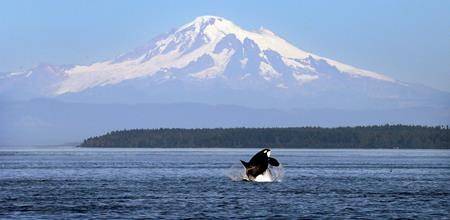American regulations that limit vessel noise and traffic around endangered killer whales off the West Coast are working, a new study says.
The U.S. National Oceanic and Atmospheric Administration, or NOAA, said in its review of regulations adopted in 2011 that the changes are benefiting southern resident orcas without having negative effects on the local whale watching and tourism industries.
The southern residents that ply the waters off British Columbia and Washington state are listed as endangered species in the United States and a species at risk in Canada.
The last census in July showed there were just 77 whales in the three pods that make up the population known to use the Salish Sea that includes the straits of Georgia, Juan de Fuca and Puget Sound.
“There is great concern right now about this population. There has been a loss of too many whales in the last six months to a year,” Michael Milstein, a spokesman for NOAA, said in an interview.
The Center for Whale Research in Washington state said as of December this year there were 76 whales, down from 83 in 2016.
Regulatory changes implemented by the American government prevent vessels from going within 200 yards, or 182 metres, from the whales.
Vessels aren’t allowed to go in the path of the whales or try to intercept them.
“We know from the science that when boats are in close proximity to the whales, they don’t forage as much and possibly don’t forage as effectively, both because they’re disturbed by the presence of the vessels and possibly by the sound of the engines,” Milstein said.
The study compared research and data on vessel compliance, biological impacts and other factors in the five years before and after the regulations were implemented.
It found the number of observed incidents of vessels interfering with whales dropped dramatically under the new regulations.
Milstein said the changes primarily applied to smaller tourism and recreation vessels, since major shipping lanes are at a distance from where the whales frequent.
Whale watching is a lucrative tourism industry in the waters off B.C. and Washington state. There were concerns the regulations would have a negative impact on the industry, but Milstein said the study found tourism tax revenues have increased significantly.
Milstein said the study found that while most commercial vessels are following the new rules, recreational boaters tended to be in the dark about regulations, signalling a need for more public education.
Canada’s Fisheries Minister Dominic LeBlanc said last fall that similar regulations will be in place before the spring to ensure vessels stay at least 200 metres away from southern resident killer whales in Canadian waters. The minister also asked whale-watching operators to voluntarily comply with the regulations in advance of their implementation.
No one from the Fisheries or Transport departments was made available for an interview.
Milstein said experts are “very pleased” Canada is moving to streamline regulations, which will help prevent confusion for boaters crossing the border.
But it’s not only recreational vessel traffic having a negative impact on the species.
Milstein said there are indications noise from larger cargo ships is affecting the southern residents but no regulations have been enacted to address the issue.
The Vancouver Fraser Port Authority launched a noise reduction trial earlier this year by asking vessels to slow down in the Haro Strait, the body of water between southern Vancouver Island and San Juan Island.
Preliminary results of the study found that slowing speeds did reduce noise, but also caused vessels to remain in an area for a longer period of time. Final results of the study are expected early this year.
Linda Givetash, The Canadian Press
Like us on Facebook and follow us on Twitter.



